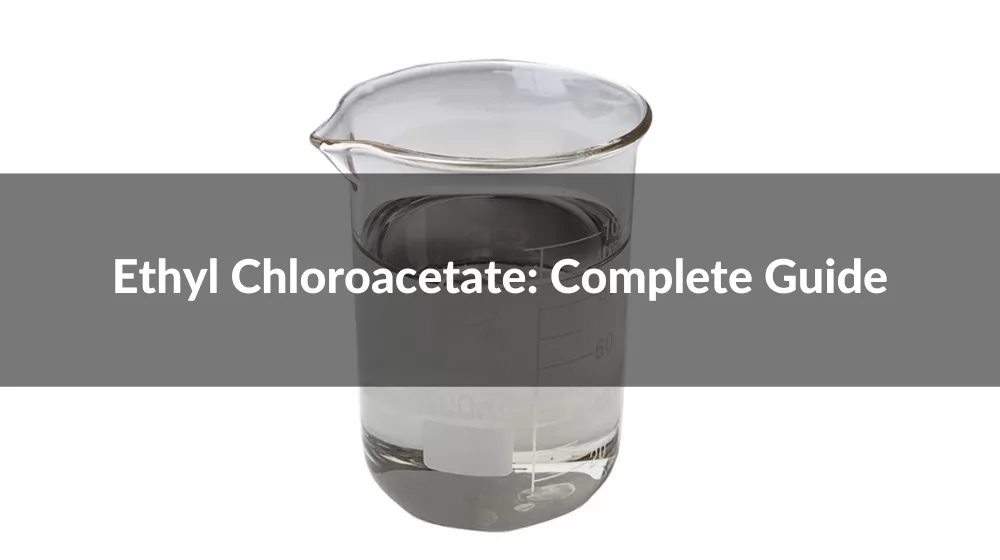

Dive into the world of Ethyl Chloroacetate, a cornerstone in the realm of chemical compounds that propels numerous industrial applications forward. Discover its chemical structure, production methods, and the significant roles it plays in pharmaceuticals, agriculture, and beyond. This comprehensive guide unfolds the multifaceted applications and vital safety guidelines associated with Ethyl Chloroacetate, paving the way for informed and safe utilization in various industrial sectors.
Ethyl Chloroacetate is a chemical compound heralded for its versatility in various industrial applications. With the molecular formula C4H7ClO2, this ester is a derivative of chloroacetic acid. This clear, colorless liquid boasts an agreeable odor and is known for its efficacy as a building block in organic synthesis. It serves as a stepping stone to manufacture a plethora of chemicals that find utility in different sectors.
The journey of Ethyl Chloroacetate begins in a reaction vessel, where ethanol interacts with chloroacetic acid under the surveillance of a catalyst. The outcome of this chemical rendezvous is our compound of interest, Ethyl Chloroacetate, alongside water which bids adieu to the reaction as a byproduct. The reaction can be summed up by the equation:
| C2H5OH + ClCH2COOH → C4H7ClO2 + H2O |
The applications of Ethyl Chloroacetate are vast and varied. It’s like the Swiss army knife in the realm of chemical compounds. It is a precursor to several other chemicals, which are instrumental in the manufacture of pharmaceuticals, agrochemicals, and dyestuffs, among others. Its competency as a reagent in organic synthesis makes it a cherished commodity in the chemical industry.
Ethyl Chloroacetate not only serves as a gateway to a myriad of chemical concoctions but also exhibits some direct applications. It plays a part in the synthesis of caffeine, and it's also a key player in the formulation of certain insecticides and herbicides. The compound's potential doesn’t stop here; it extends to being an effective solvent in certain chemical reactions due to its good miscibility with organic solvents.
In a nutshell, Ethyl Chloroacetate is a character actor that shines in supporting roles, whether it's kickstarting a chemical reaction or giving other compounds a leg up in the industrial scene. Its profile as a chemical workhorse underscores its significance and unlocks an arena of possibilities in scientific and industrial exploits.
The stature of Ethyl Chloroacetate in the chemical industry is akin to a master key, unlocking doors to myriad chemical reactions and products. Its role is pivotal, acting as a linchpin that holds together various industrial processes. The resonance of Ethyl Chloroacetate is felt across a spectrum of sectors within the chemical industry, carving a niche for itself as an indispensable asset.
One of the foremost merits of Ethyl Chloroacetate is its role as a precursor to other chemicals. It's like the opening act that sets the stage for the stars of the show - other chemical compounds. Its derivative nature paves the way for the synthesis of numerous chemicals that are instrumental in pharmaceuticals, agrochemicals, and dyestuffs. This cascading effect amplifies its importance, making it a cornerstone for various chemical formulations.
Moreover, Ethyl Chloroacetate's efficacy as a reagent in organic synthesis is a testament to its utility. It facilitates a gamut of reactions, enabling the creation of compounds that are pivotal in drug development, agricultural innovations, and colorant industries. It's not just a participant, but a key player, orchestrating chemical reactions to yield desired products.
The versatility of Ethyl Chloroacetate extends to being an effective solvent in certain reactions. Its good miscibility with organic solvents enhances its desirability, rendering it a go-to choice for various industrial applications. This quality elevates its status from being merely useful to being quintessential in achieving specific chemical objectives.
In the grand scheme of things, Ethyl Chloroacetate embodies the spirit of industrial chemistry - a conduit through which scientific innovation translates into tangible products. Its relevance in the chemical industry is not a fleeting one; it's etched into the core of many industrial processes, making it a stalwart in the realm of chemical engineering.
As we delve deeper into the intricacies of Ethyl Chloroacetate in subsequent chapters, its multifaceted roles and the ripple effect it creates in the chemical industry become even more evident. Its story is a compelling narrative of how a single compound can ripple out to impact an entire industry, underscoring the boundless potential encased in the molecular structure of Ethyl Chloroacetate.
The molecular formula of Ethyl Chloroacetate is C4H7ClO2. This compound belongs to the ester family, showcasing a structure where an ethyl group is bonded to a chloroacetic acid moiety. The structural formula is often represented as CH3COOCH2Cl. The bond between the oxygen atom of the ethyl group and the carbon atom of the acetic moiety defines its ester character, while the chlorine atom imparts distinct properties to the compound.
Ethyl Chloroacetate manifests as a clear, colorless liquid at room temperature, with a pleasant, ester-like odor. Here's a breakdown of some of its key physical and chemical properties:
| Property | Value |
|---|---|
| Molecular Weight | 122.55 g/mol |
| Boiling Point | 143 - 144°C |
| Melting Point | -26°C |
| Density | 1.138 g/cm3 |
| Solubility | Miscible with organic solvents |
| Flash Point | 52°C |
These physical and chemical properties play a pivotal role in determining the utility and handling of Ethyl Chloroacetate in industrial applications. Its relatively low boiling point and high miscibility with organic solvents make it a suitable candidate for various reactions and processes in the chemical industry. The compound's structure, especially the presence of the chlorine atom, makes it a reactive entity, capable of engaging in a multitude of chemical reactions, thus broadening its application spectrum.
The realm of Ethyl Chloroacetate is broad and intriguing. Its chemical structure is the foundation upon which its industrial relevance is built, and its properties are the pillars that support its widespread use. As we venture further into the world of Ethyl Chloroacetate, the profound impact of these characteristics on its applications and safety measures will become increasingly apparent.
The production of Ethyl Chloroacetate primarily hinges on two raw materials: ethanol and chloroacetic acid. The preparation phase involves ensuring the purity and quality of these materials to facilitate a smooth production process. Ethanol, being a common industrial solvent, is readily available in high purity. Chloroacetic acid, on the other hand, might require purification to meet the desired standards.
The synthesis of Ethyl Chloroacetate is typically carried out through esterification, a reaction between ethanol and chloroacetic acid. This reaction is facilitated by the presence of a catalyst such as sulfuric acid. Here’s a simplistic representation of the process:
C2H5OH + ClCH2COOH → C4H7ClO2 + H2O
The reaction occurs in a controlled environment, often under specific temperature and pressure conditions to ensure the highest yield and purity of Ethyl Chloroacetate. The process may also involve subsequent distillation to purify the product further.
Ethyl Chloroacetate is commercially available from various chemical suppliers and manufacturers. Its production is scaled to meet the demands of a wide range of industries, making it a readily available compound. However, the purity and specifications might vary from one supplier to another, necessitating a thorough evaluation before procurement for industrial use.
Furthermore, manufacturers often provide options for bulk purchases, ensuring a steady supply for large-scale industrial applications. The commercial availability of Ethyl Chloroacetate underscores its importance and the critical role it plays in the chemical industry, enabling a continuum of research, development, and production activities.
Ethyl Chloroacetate is a celebrated reagent in organic synthesis due to its capability to partake in a wide array of chemical reactions. Its structure lends itself to reactions like nucleophilic substitution, making it a go-to reagent for the formation of a multitude of other organic compounds. By acting as a stepping stone, Ethyl Chloroacetate facilitates the synthesis of complex molecules, thereby broadening the horizons of organic chemistry.
The pharmaceutical industry owes a debt of gratitude to Ethyl Chloroacetate. Its application as a building block for the synthesis of active pharmaceutical ingredients (APIs) is invaluable. It plays a critical role in the production of various drugs, thereby contributing to advancements in medical science and health care. Its derivative compounds form the backbone of several medications that are pivotal in treating a range of ailments.
In agriculture, Ethyl Chloroacetate finds its use in the creation of agrochemicals like herbicides and insecticides. Its reactivity makes it a key ingredient in formulations aimed at pest control and crop protection. By serving as a precursor to chemicals that safeguard crops, Ethyl Chloroacetate plays an indirect yet impactful role in securing food resources and promoting agricultural sustainability.
Beyond pharmaceuticals and agriculture, Ethyl Chloroacetate's utility extends to several other industrial sectors. It's used in the production of dyestuffs, contributing to the colorant industry. Additionally, its role as a solvent and a reagent makes it a valuable asset in various chemical processes across different industries. The spectrum of applications showcases the multifaceted nature of Ethyl Chloroacetate, underscoring its significance in the industrial landscape.
Exposure to Ethyl Chloroacetate can pose health risks, and it’s imperative to understand and mitigate these risks to ensure safety. Inhalation, ingestion, or skin contact can lead to irritation and other adverse health effects. Therefore, adequate safety precautions should be observed. These include the use of personal protective equipment (PPE) like gloves, eye protection, and respirators. Ventilated work areas can mitigate inhalation risks, while eye wash stations and safety showers can be crucial in case of exposure.
Handling Ethyl Chloroacetate requires adherence to safety guidelines to prevent accidents. It's advisable to avoid contact with the skin or eyes and to ensure adequate ventilation during handling. Storage should be in a cool, well-ventilated area away from incompatible materials such as strong bases or oxidizing agents. Containers should be tightly sealed to prevent leakage and evaporation, and clearly labeled to ensure proper identification. Spill containment measures should be in place to manage any accidental spills efficiently.
Furthermore, training personnel on the correct handling procedures and emergency response actions can significantly contribute to a safer working environment. Regular inspection and monitoring of storage areas can also aid in early detection of potential issues such as leaks or contamination.
Ethyl Chloroacetate's environmental footprint is a topic of concern due to its chemical nature. Its biodegradation potential is a significant factor in assessing its environmental impact. While it can undergo biodegradation under certain conditions, the rate and extent can vary based on environmental factors. The toxicity of Ethyl Chloroacetate to aquatic life and other organisms is a matter of study, and its release into the environment should be controlled to minimize adverse effects.
The production, handling, and disposal of Ethyl Chloroacetate are governed by a regulatory framework to ensure environmental safety. These regulations stipulate the permissible levels of emissions, waste disposal methods, and other practices to mitigate environmental harm. Compliance with these regulatory guidelines is crucial for operations involving Ethyl Chloroacetate to ensure they are conducted in an environmentally responsible manner.
Furthermore, manufacturers and users of Ethyl Chloroacetate are encouraged to adhere to best practices that go beyond the regulatory requirements. This includes investing in waste reduction and recycling technologies, implementing stringent safety measures, and engaging in continual monitoring and reporting of environmental performance.
It's imperative for entities involved with Ethyl Chloroacetate to foster a culture of environmental stewardship, ensuring that the utilization of this valuable chemical compound is balanced with the imperative of environmental preservation and sustainability.
In the realm of chloroacetates, Ethyl Chloroacetate stands as a versatile compound. However, when compared to other chloroacetates like Methyl Chloroacetate or Butyl Chloroacetate, certain distinctions come to light. Each of these compounds has its own set of properties and applications, dictated by the varying alkyl groups they possess. For instance, Methyl Chloroacetate might exhibit higher reactivity due to its smaller alkyl group, while Butyl Chloroacetate may have a lower reactivity owing to its larger alkyl group.
The choice between these chloroacetates often hinges on the specific requirements of a reaction or an application. Ethyl Chloroacetate often finds a sweet spot, offering a balanced profile of reactivity and stability which makes it a preferred choice in many industrial scenarios.
The benefits of Ethyl Chloroacetate are manifold. Its balanced reactivity profile, coupled with its efficacy as a solvent and a reagent, make it a valuable asset in organic synthesis, pharmaceuticals, and other sectors. Furthermore, its commercial availability and established production methods contribute to its appeal in the industrial arena.
On the flip side, the handling of Ethyl Chloroacetate requires adherence to safety protocols due to its potential health hazards. Its environmental impact, if not managed properly, can also pose challenges. Moreover, compared to other chloroacetates, it may sometimes fall short in terms of reactivity or other specific properties desired for certain specialized applications.
The exploration of Ethyl Chloroacetate unveils a narrative of a compound that’s central to the progression of numerous industrial sectors. Its synthesis and utilization are a testament to the boundless ingenuity within the chemical industry. As the journey of Ethyl Chloroacetate continues to evolve, leading manufacturers like High Mountain Chem are at the forefront of delivering high-quality Ethyl Chloroacetate to meet the demanding needs of the industry. Discover more about Ethyl Chloroacetate and the exemplary standards of High Mountain Chem at www.highmountainco.com.









